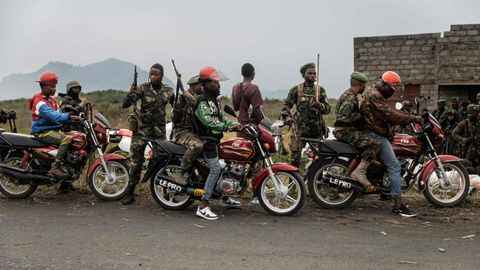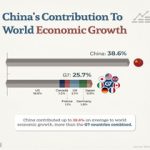Eastern Goma, home to over 2 million people and a regional center for security and humanitarian initiatives, is under siege by a rebel group that Kinshasa says is supported by Rwanda.
As M23 rebels fight the Congolese army, they are gradually advancing on Goma and taking control of a nearby town, causing panic in the largest metropolis of the eastern Democratic Republic of the Congo (DRC).
On Thursday, hundreds of injured civilians were transported from the combat area to the main hospital after bombs were heard detonating in the city’s far-flung fringes.
The roughly 2 million-person city of Goma, which serves as a regional center for security and humanitarian operations, is coming closer to the rebel group, which has made great strides in recent weeks.
Sake, a village just 27 kilometers from Goma and one of the remaining major routes into the provincial capital still under government control, was captured by the rebels on Thursday, the UN chief said.
About 120 armed groups, including M23, have been fighting for control of the mineral-rich eastern Democratic Republic of the Congo (DRC), which is bordered by Rwanda. The conflict has lasted for decades and resulted in one of the worst humanitarian catastrophes in history.
The fighting has resulted in the displacement of about 7 million people. The towns of Minova, Katale, and Masisi, west of Goma, were taken by M23 earlier this month.
According to M23 spokesperson Lawrence Kanyuka, “the people of Goma have suffered greatly, like other Congolese,” on X. “M23 is on its way to liberate them, and they must prepare to welcome this liberation.”
On Thursday morning, Goma schools sent children home as word of fighting spread.
“The enemy is reportedly attempting to enter the city. We are instructed to return home because of this,” stated Hassan Kambale, a 19-year-old high school student. “We are constantly waiting for the bombs.”
Rwanda denies the DRC’s assertion.
Rwanda is accused by Kinshasa, the US, and UN experts of supporting the M23, which is primarily made up of ethnic Tutsis who split from the army more than ten years ago.
Although the Rwandan government refutes the claim, it acknowledged last year that it maintains troops and missile systems in eastern DRC to protect its security, citing a concentration of DRC military close to the border. Rwandan military in eastern DRC may number as much as 4,000, according to UN analysts.
Speaking to French television France 24 on Wednesday, DRC’s Minister of Communication Patrick Muyaya stated that going to war with Rwanda is a “option to consider.”
Late Thursday, Antonio Guterres, the secretary general of the United Nations, denounced “in the strongest terms, the renewed offensive launched by the 23 March Movement (M23),” which included the “seizure of Sake.”
“This offensive has a devastating toll on the civilian population and heightened the risk of a broader regional war,” the statement said. He additionally called on “all parties to uphold human rights and international humanitarian law.”
“Unfortunately, others did not escape, but we did.”
The US Embassy in Kinshasa, the capital of the Democratic Republic of the Congo, issued a letter alerting US citizens in North Kivu province, which contains Goma, to “an increase in the severity of armed conflict near Sake” and advising them to be vigilant in case they need to leave their houses at short notice.
Additionally, the UK released a travel alert, stating that M23 currently controls Sake and advising British citizens to evacuate Goma as long as the roads are still open.
Over 178,000 Sake residents have left the M23 advance in the past two weeks, and many more have joined.
With hundreds of new injuries on Thursday, the CBCA Ndosho Hospital in Goma was overcrowded.
On Wednesday, thousands of people fled the conflict by boat, crossing Lake Kivu to the north and overflowing out of crowded wooden boats at Goma, some of them carrying bundles of their possessions wrapped across their foreheads.
According to Neema Matondo, she left Sake in the middle of the night when the first explosions occurred. She described witnessing the murder and destruction of those around her.
Matondo told the AP news agency, “We escaped, but unfortunately” others did not.
Mariam Nasibu, who fled Sake with her three kids, was crying because one of them was blasted off in the constant shelling and lost a leg.
“As I continued to flee, another bomb fell in front of me, hitting my child,” she added while weeping.
No barriers in the way of Goma
Early this month, M23 rebels took control of Masisi, the administrative center of Masisi territory in North Kivu province, which is home to some 40,000 people and is located about 80 kilometers northwest of Goma.
About ten kilometers separate Goma and the nearest battleground.
After over two years of occupation of the hills surrounding Goma, the armed group now poses a threat to the city’s economy by seizing the port of Minova in the west.
Defensive lines have been set up throughout the city by the FARDC and militias supporting the army.
However, many question whether these forces could provide effective defense against an attack.
Although MONUSCO, a UN peacekeeping force, has a base in Goma, it is uncertain how it will respond if the city collapses.
As part of a peace initiative organized by Angola, a December meeting between Presidents Felix Tshisekedi of the Democratic Republic of the Congo and Paul Kagame of Rwanda was canceled because of a lack of consensus.
“Nothing prevents the M23 and Rwanda from trying to take Goma,” Reagan Miviri, a researcher at the Congolese Ebuteli institute, told the AFP news agency at this point.
“Neither the American pressure nor the Luanda process are present anymore. Rwanda appears to tolerate this aggression, therefore there’s nothing to be afraid about,” he remarked.
When Kagame visited Ankara on Thursday, Turkish President Recep Tayyip Erdogan pledged his nation’s assistance, saying it was “necessary to resolve this issue which will contribute to stability and peace in the Great Lakes Region, should both parties wish for it.”
Additionally, some analysts worry that Rwandan sentiment may change as a result of Donald Trump’s return to the White House. Even on the geopolitical level, Kagame recently declared that he was “certain” that “many things, even those linked to the east of the DRC, will change.”
The Eastern Democratic Republic of Congo is home to abundant mineral resources and a complicated network of conflicting armed groups, where violence has fluctuated since the 1990s regional conflicts.
Former militants of the National Congress for the Defence of the People (CNPD), a Tutsi-majority political-military force in the Democratic Republic of the Congo that is currently dormant, rebelled within the army to form the M23 in 2012.
By the end of November 2012, it had already seized Goma.
However, with the assistance of the UN mission in the DRC and diplomatic pressure from the international community on Rwanda, the DRC’s army had retaken the city eleven days later.
The FARDC had expelled the armed group from its final strongholds in the North Kivu mountains by the end of 2013.
The DRC’s army has hardly regained the ground it has lost in recent months since the M23 reappeared at the end of 2021.






